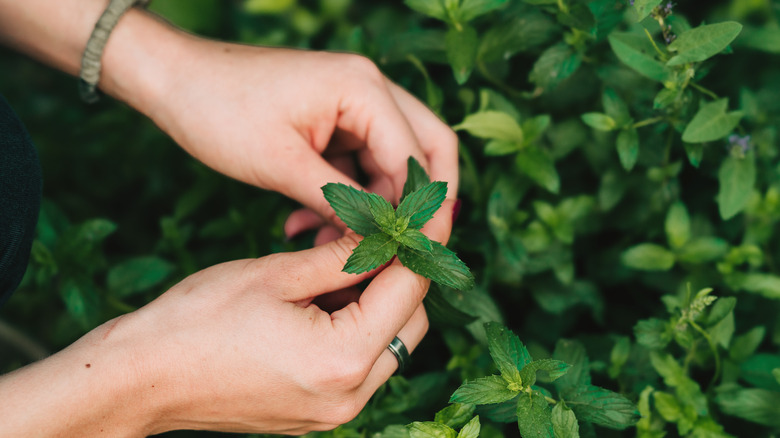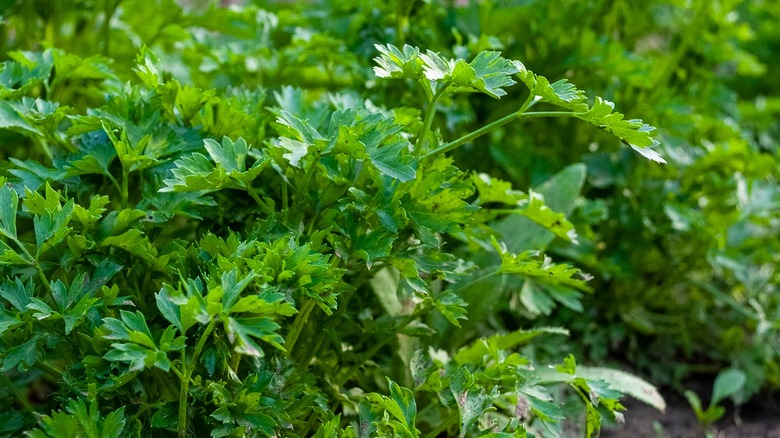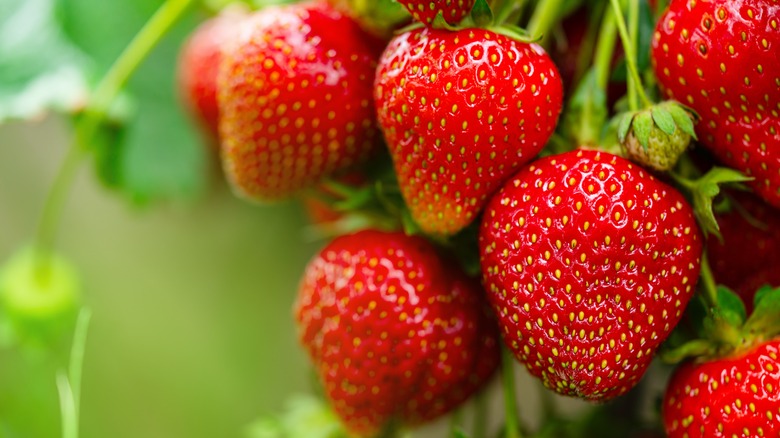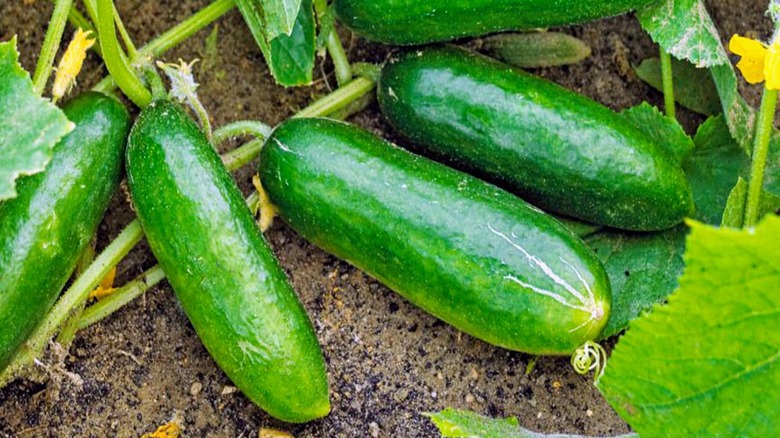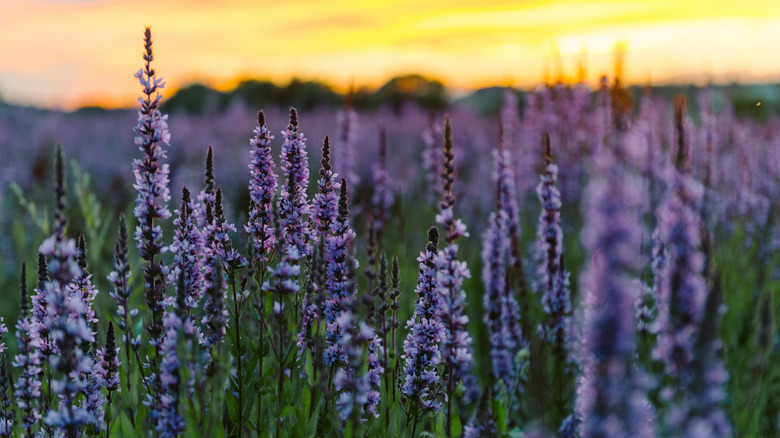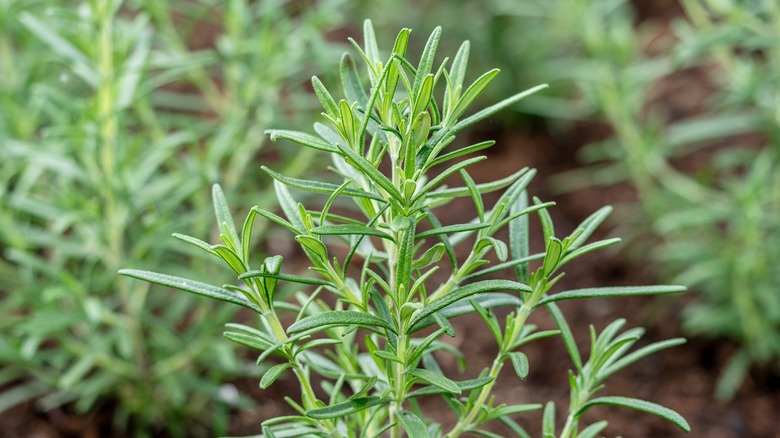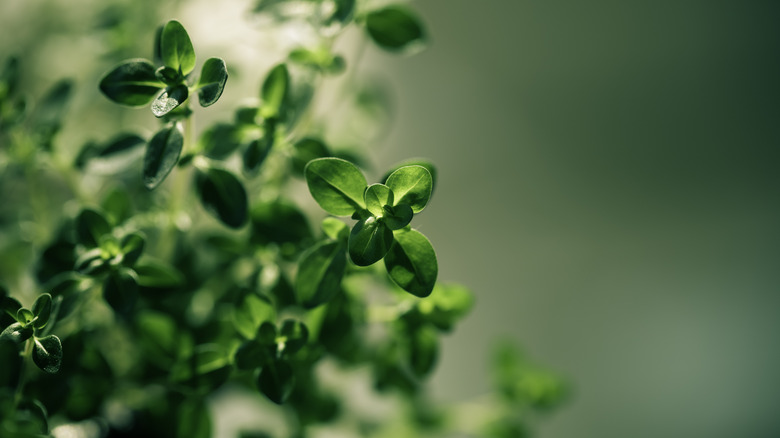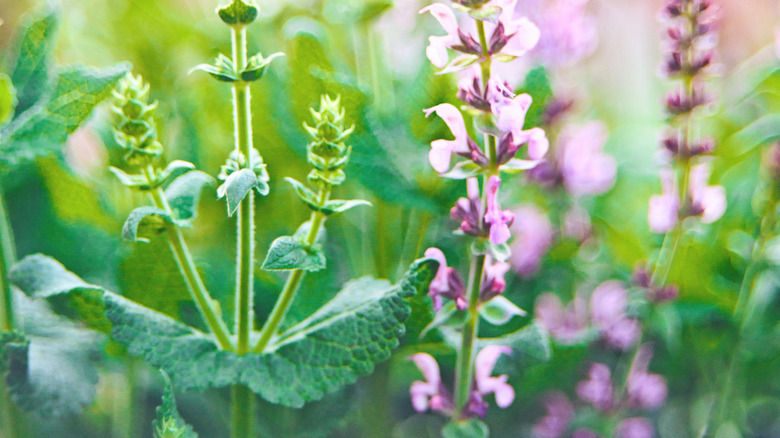Herbs And Other Crops You Should Avoid Growing Alongside Mint
Mint is a fragrant herb with lots of culinary uses and a garden favorite for many homeowners. However, it's an aggressive plant with roots that spread quickly and foliage that gets tall fast. This fast pace of growth enables mint to outcompete nearby plants for nutrients, rob them of the sun, and stifle their roots. Mint also prefers growing conditions that clash with most other common garden herbs. For example, mint needs more frequent watering and soil that's more acidic than rosemary, lavender, and thyme.
So, make sure that you know which plants grow well next to mint before you get started with your garden. Great companion plants increase each others' nutrient absorption, put up a mutual defense against pests, and share resources well. On the other hand, poor companion plants compete for nutrients, water, and sunlight. Some can even infect their neighbor with a serious disease. Below, we've compiled a list of plants that won't grow well together with mint, along with alternatives that make better mint companions.
Parsley won't get enough sunlight with mint nearby
Parsley is a hardy biennial herb whose fragrant leaves make an excellent addition to your edible garden. But if you plan to grow parsley, be sure to situate it far from any mint plants, as they don't make the best companion plants. That's partly because mint is generally faster growing than parsley. Parsley grows to about 1½ feet within a year of planting. Most mint varieties grow well over 2 feet and as wide as 3 feet in the same time frame. If you place mint close to parsley, its foliage will quickly eclipse the parsley plants and deprive them of much-needed sunlight. You'd also struggle to keep both plant species happy since parsley prefers a neutral-to-alkaline soil, whereas mint thrives in slightly acidic soil.
Instead of parsley, consider planting cilantro alongside your mint. Cilantro is an annual herb that's hardy in USDA zones 2-11. While it doesn't grow as tall as mint, it benefits from the latter's shadow during the hottest parts of the day. Cilantro also has similar requirements as mint, as it thrives in moist, somewhat acidic soil.
If you're set on growing parsley in your garden, you have several suitable companion plants from which to choose. For example, parsley does well when planted close to basil and tomatoes. Parsley can even protect tomatoes from common pests. Hoverflies, which feed on aphids, are drawn to parsley's blooms. By inviting these predatory insects, parsley flowers keep your tomatoes aphid-free.
Strawberry can pick up a verticillium wilt infection from mint
Strawberry is a hardy perennial herbaceous plant whose famous aromatic fruit is abundant in early summer. But if the delicious berries and ease of growing tempt you into planting them, keep them away from any mint in your garden. Mint is a dangerous companion for strawberries because it can infect them with a fatal illness. Several common mint varieties in the U.S. are vulnerable to verticillium wilt, a fungal disease that's often fatal for a number of plants, and strawberries in particular. Verticillium wilt spreads through the soil and invades plants via their roots. This means that it's not only dangerous to grow strawberries next mint; you shouldn't even plant them in the same soil where mint used to grow.
If you have mint in your garden and are concerned about it spreading verticillium wilt to other plants, choose a companion that's resistant to the disease. Spinach and carrots, for example, are not susceptible to wilt. What's more, both make excellent companions for mint. And if you want to have mint growing near any fruit- or berry-producing plant, mulberry is a great choice because it's also resistant to verticillium wilt.
You can still grow strawberries in your garden safely. Consider planting them next to asparagus, spinach, or lettuce. Growing strawberries alongside borage is particularly beneficial since this herb attracts pollinators and predator insects while driving common strawberry pests away.
Cucumbers might change their flavor because of mint
A cucumber plant is a creeping vine that produces the widely used refreshing namesake fruits. These plants' hardiness and ability to bear fruit with minimal care make them an attractive garden choice, but you should be careful with where you plant them. Keeping your cukes away from mint is job one. While cucumbers and mint pair nicely in a salad (and some delicious cocktails), you don't want all your cukes to have a menthol flavor. But when you grow mint and cucumber as companion plants, you may find that the mint flavor seeps into the cucumber fruits. Moreover, cucumbers and mint are likely to compete for nutrients and water when grown nearby.
On the other hand, mint actually improves (without overpowering) the taste of certain crop plants. These include cabbage and tomatoes, which thrive as mint companion plants. When grown with tomatoes, mint acts as a pesticide, too, by warding off insects and weeds.
If you must have cucumbers and mint in your garden, simply keep the two plants safely apart. Instead of mint, plant your cukes next to legumes, alliums, and root vegetables like carrots. They will not affect each other's flavor, nor will they compete for space or nutrients.
Lavender can't thrive in the acidic soil mint prefers
Lavender is a herbaceous perennial known for its distinct aroma, as well as medicinal and culinary properties — much like mint. The two herbs even come from the same Lamiaceae family. But despite these similarities, lavender and mint are not a great match for garden companionship because they prefer vastly different growing conditions. Lavender grows well in dry, poor soil that's either neutral or alkaline — a type of soil that's inhospitable to mint. In contrast, mint prefers to have its roots in somewhat moist soil that's a bit acidic.
That said, you can easily grow mint and lavender in your garden, provided that you're located in one of lavender's hardiness zones (5-9). Just plant the two herbs far enough to keep their soil acidities different. This way, you can neutralize acidic soil using lime to suit lavender's preferences without disturbing the mint's habitat. Jersey Lavender recommends adding garden lime to the soil several months before planting your lavender seedlings in it. This time gives lime enough time to change the soil's pH level.
While lavender is not an ideal companion plant for mint, you can grow lavender alongside certain similar perennials. For example, rosemary, salvia, and oregano are all suitable companion plants for the aromatic herb. You can even plant lavender next to catmint, a member of the mint family that flourishes in the same soil type as lavender.
Rosemary will lose out on nutrients and space to nearby mint
Rosemary is a perennial herb with a distinct aroma redolent of pine and camphor. Similar to mint, rosemary's distinct taste and fragrance make it desirable in edible gardens. But if you plan to grow these two culinary gems together, beware. Only one will thrive, and spoiler alert: It isn't rosemary.
Mint will quickly deprive rosemary of both space and nutrients. Although rosemary is much taller than mint in adulthood, it takes several years to get to its full height of 5 feet, as it inches up ½ a foot per season. On the other hand, mint shoots out to 2 feet or more in a single year. This rapid growth allows it to quickly block the sunlight rosemary needs to thrive. As mint gets bigger, its hydration needs increase, so it siphons off rosemary's water supply, too. Additionally, rosemary likes dry, neutral-to-alkaline soil, whereas mint requires moist soil with a lower pH level.
You have two options for helping mint and rosemary coexist. First, you can plant them far apart and tailor their soil conditions accordingly. For example, you can add garden lime to reduce soil acidity to rosemary's preferred level. Conversely, acidifiers like peat moss, elemental sulfur, and iron sulfate will lower the soil's pH level to mint's liking if your garden soil is naturally alkaline. However, if this method sounds like too much trouble, there's a simpler alternative — just grow one of the plant species in a pot.
Thyme won't tolerate the quantities of water mint needs to thrive
Thyme belongs to the same family as mint and is also a garden staple thanks to its culinary uses. Where these two distant siblings differ is their preference for water. Most mint varieties require watering every 2-4 days on average. While you shouldn't turn the soil around your mint plantings into a marsh, it should remain consistently moist for the plants to flourish. On the other hand, thyme needs no more than a single watering every two weeks or so. If you grow the two as companion plants, the outcome is predictable — you'll either overwater the thyme or underwater the mint. Thyme's preference for an alkaline substrate makes these two potential companions even more incompatible.
You can grow mint and thyme together as long as one of the plants is potted or if they're far away from each other. If you plant both in the garden, make sure the plants' unique soil conditions are met. Alternatively, you can find other suitable companions for your mint, like dill and basil, which can survive in similar levels of soil moisture. For example, dill benefits from biweekly waterings, while basil can require water up to three times per week in the warm season.
If you still want a suitable companion plant for your thyme, consider planting it with other members of the Lamiaceae family that like dry soil. Oregano, rosemary, lavender, and sage are excellent choices.
Sage and mint need different habitats to thrive
Sage is an evergreen subshrub belonging to the same family as mint. Like mint, sage often finds itself in kitchens, where its aromatic leaves are used to flavor various dishes. Despite their similarities, mint and sage are not ideal companion plants due to differing water requirements. Sage that's planted in the ground requires no watering once established unless there's a persistent lack of rain. On the other hand, mint needs to be watered at least biweekly and as often as every other day during the hottest part of the year. Planting them as companion plants would result in one of the plants getting too much or too little water.
You can still grow sage and mint together in your garden, just not close enough to interfere with each plant's watering needs. For example, you can plant sage in a raised bed to enable good soil drainage while letting mint grow in-ground nearby. Alternatively, plant the two in separate beds or in-ground with a bit of space between them. And don't fret about light requirements or soil acidity — mint and sage like full sun and a slightly acidic substrate.
